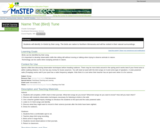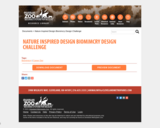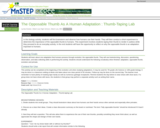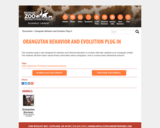
441 Results


Students will learn to identify 3 to 4 birds by their song.
- Subject:
- Biology
- Science
- Material Type:
- Activity/Lab
- Provider:
- Science Education Resource Center (SERC) at Carleton College
- Provider Set:
- Pedagogy in Action
- Author:
- Charlie Schweigert
- Date Added:
- 02/24/2021

This resource provides infromation about careers in marine mammal biology.
- Subject:
- Career and Technical Education
- Science
- Material Type:
- Reading
- Provider:
- National Oceanic and Atmospheric Administration (NOAA)
- Date Added:
- 12/01/2023

This resource provides information about the careers in microbiology.
- Subject:
- Career and Technical Education
- Science
- Material Type:
- Reading
- Provider:
- National Oceanic and Atmospheric Administration (NOAA)
- Date Added:
- 12/01/2023

Part of the National Park Service website, this page provides general info. about the resident bat population, and links to more specific bat info. For the bat enthusiast!
- Subject:
- Science
- Material Type:
- Reading
- Provider:
- National Park Service/U.S. Department of the Interior
- Date Added:
- 06/05/2022

Great site providing a "Quickindex" to find various resources. Also included are links to more information on this museum.
- Subject:
- Science
- Material Type:
- Reading
- Provider:
- The Trustees of the Natural History Museum, London (UK)
- Date Added:
- 12/01/2023

These wonderful virtual field trips allow students to explore a coastal rain forest or the coral reefs in the Dominican Republic, and so much more.
- Subject:
- Mathematics
- Science
- Material Type:
- Full Course
- Provider:
- The Nature Conservancy
- Date Added:
- 07/01/2022

How could a biomimetic-inspired exhibit design improve an animal exhibit, either for the animals and/or for the people using it? This activity is designed to start your students in recognizing themselves as scientists and thinking critically about problem-solving. The goal is to teach concepts through discovery and to encourage using scientific thought processes. As with all lessons provided, please feel free to adapt them according to your students’ abilities. You may find it more successful to lead activities and discussions as a whole group as opposed to having your students’ work in small groups. Certain scientific vocabulary may or may not be appropriate for your students’ level of understanding. Take these ideas, make them your own and your students will have a greater chance at success.
- Subject:
- Environmental Science
- Life Science
- Science
- Material Type:
- Lesson Plan
- Provider:
- Cleveland Metroparks Zoo
- Date Added:
- 12/15/2021

How can nature inspire a design for more effective medical equipment to be used in providing veterinary care? This activity is designed to start your students in recognizing themselves as scientists and thinking critically about problem-solving. The goal is to teach concepts through discovery and to encourage using scientific thought processes. As with all lessons provided, please feel free to adapt them according to your students’ abilities. You may find it more successful to lead activities and discussions as a whole group as opposed to having your students’ work in small groups. Certain scientific vocabulary may or may not be appropriate for your students’ level of understanding. Take these ideas, make them your own and your students will have a greater chance at success.
- Subject:
- Science
- Material Type:
- Lesson Plan
- Provider:
- Cleveland Metroparks Zoo
- Date Added:
- 12/15/2021

On this site, find short minute-long videos from Nature for students to become active learners about topics from animal homes to spiders at work.
- Subject:
- Science
- Material Type:
- Module
- Provider:
- PBS LearningMedia
- Date Added:
- 11/06/2023

This activity is an investigation where students observe cells from various organisms and then compare and contrast the cells they observe.
- Subject:
- Biology
- Science
- Material Type:
- Activity/Lab
- Provider:
- Science Education Resource Center (SERC) at Carleton College
- Provider Set:
- Pedagogy in Action
- Author:
- Roxanne Schmiesing
- Date Added:
- 02/24/2021

What types of behaviors might elephants exhibit if they are threatened? What types of behaviors might elephants exhibit if they are at play? This activity is designed to start your students in recognizing themselves as scientists and thinking critically about problem-solving. The goal is to teach concepts through discovery and to encourage using scientific thought processes. As with all lessons provided, please feel free to adapt them according to your students’ abilities. You may find it more successful to lead activities and discussions as a whole group rather than using individual Research Plan sheets. Certain scientific vocabulary may or may not be appropriate for your students’ level of understanding. Take these ideas, make them your own and your students will have a greater chance at success.
- Subject:
- Science
- Material Type:
- Lesson Plan
- Provider:
- Cleveland Metroparks Zoo
- Date Added:
- 12/15/2021

This is a classroom activity in which students observe and describe cells in stages of division. They share observations about what they see in the cells, then formulate questions and do research concerning the changes that take place in cells during the process.
- Subject:
- Biology
- Science
- Material Type:
- Activity/Lab
- Provider:
- Science Education Resource Center (SERC) at Carleton College
- Provider Set:
- Pedagogy in Action
- Author:
- Vickie Kuchta
- Date Added:
- 02/24/2021

In this activity students will explore leaves using inquiry and their senses.
- Subject:
- Life Science
- Science
- Material Type:
- Activity/Lab
- Lesson Plan
- Provider:
- Science Education Resource Center (SERC) at Carleton College
- Provider Set:
- Pedagogy in Action
- Author:
- marcia orcholski
- Date Added:
- 02/24/2021

Smithsonian Institution presents ?Ocean Planet: Interdisciplinary Marine Science Activities?. Through this series of six interdisciplinary lessons, students will look at such things as the organisms in different marine ecosystems, the many different products we get from our seas, and the effects of pollution on our oceans. Teachers and students alike will love the easy to understand background information and vibrant photos. Each lesson comes complete with clear learning objectives and instructions, as well as supplemental resources and student handouts.
- Subject:
- Science
- Material Type:
- Lesson Plan
- Provider:
- Smithsonian Institution
- Provider Set:
- Smithsonian Learning Lab
- Date Added:
- 08/24/2023

In this lesson, students will use the Arcadia Earth app to learn about and develop a foundational understanding of our oceans.
Estimated time required: 1 class period.
Technology required for this lesson: Tablet or Smartphone.
- Subject:
- Biology
- Science
- Material Type:
- Lesson Plan
- Provider:
- Verizon
- Provider Set:
- Verizon Innovative Learning HQ - Lessons and Apps
- Author:
- Belle Isle Conservancy
- Date Added:
- 09/20/2023

The goal of this program is to get your students to answer one question — can the reintroduction of a wetland dependent
animal, such as the trumpeter swan, increase the level of conservation both for the habitat and the
species? Of course this one question leads to a million other questions and that is the purpose of the lessons.
plans. We have tried to develop lessons based on some smaller questions that would eventually lead the student
back to the larger problem they are trying to solve. Each
- Subject:
- Environmental Science
- Science
- Material Type:
- Unit of Study
- Provider:
- Cleveland Metroparks Zoo
- Date Added:
- 12/15/2021

In the Arcadia Earth app section titled “Sustainability Beneath the Surface,” students are introduced to several factors that impact ocean health. This lesson takes a deeper dive into one specific challenge: overfishing. Through the game, “One Fish, Two Fish,
Overfishing, NO Fish,” students discover how fishing management reformation is necessary to sustain fish populations and prevent permanent supply collapses.
Estimated time required: 1 class period.
Technology required for this lesson: Tablet or Smartphone.
- Subject:
- Biology
- Science
- Material Type:
- Lesson Plan
- Provider:
- Verizon
- Provider Set:
- Verizon Innovative Learning HQ - Lessons and Apps
- Author:
- Belle Isle Conservancy
- Date Added:
- 09/20/2023

In this biology activity, students will first brainstorm how humans use their hands. They will then conduct a short experiment to determine the importance of the opposable thumb to humans and how it is an important adaptation.
- Subject:
- Biology
- Science
- Material Type:
- Activity/Lab
- Assessment
- Lesson Plan
- Provider:
- Science Education Resource Center (SERC) at Carleton College
- Provider Set:
- Pedagogy in Action
- Author:
- Lynda Kiesler
- Date Added:
- 02/24/2021

This evolution plug in was designed for teachers and informal educators to conduct with their students at an orangutan exhibit . The students will learn basic natural history information about orangutans, how to conduct basic behavioral research.
- Subject:
- Biology
- Life Science
- Science
- Material Type:
- Lesson Plan
- Provider:
- Cleveland Metroparks Zoo
- Date Added:
- 12/15/2021